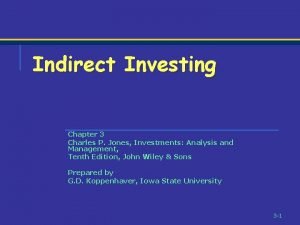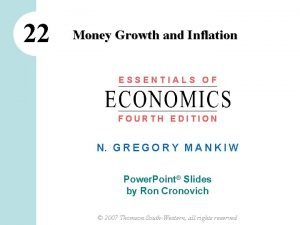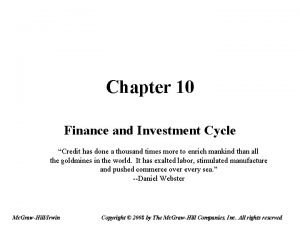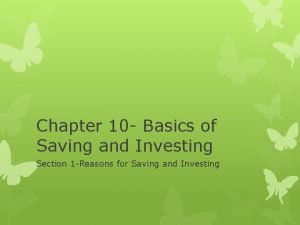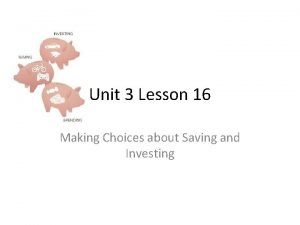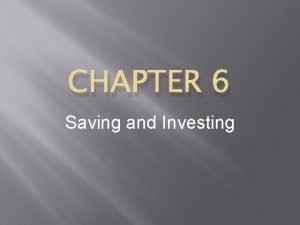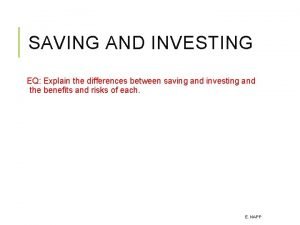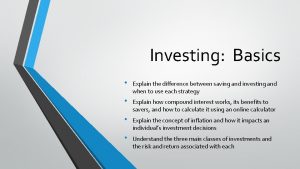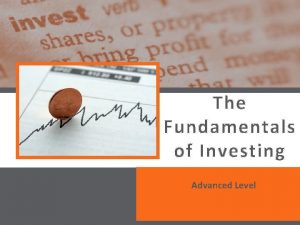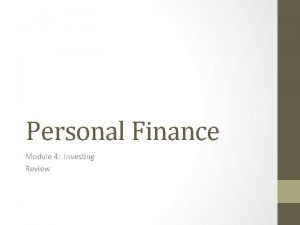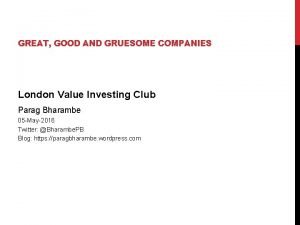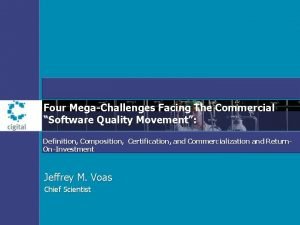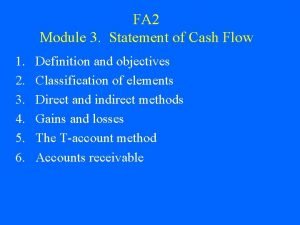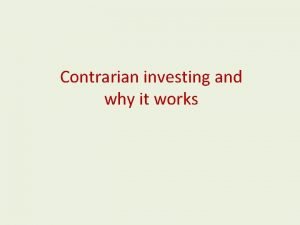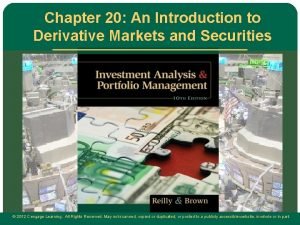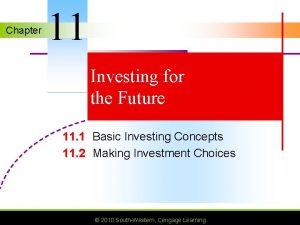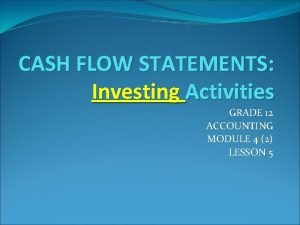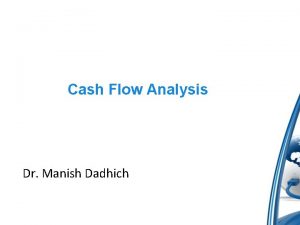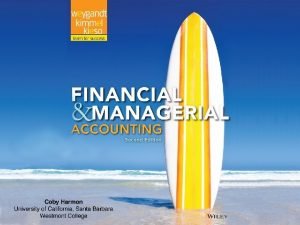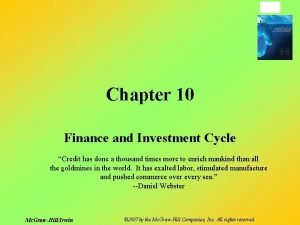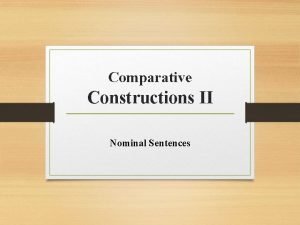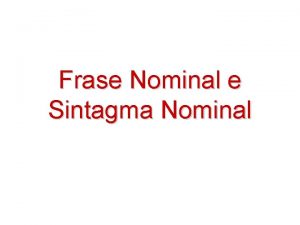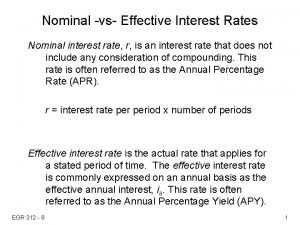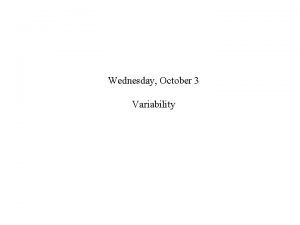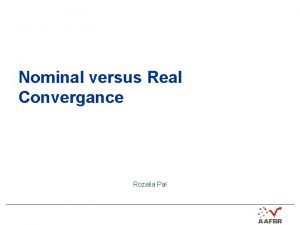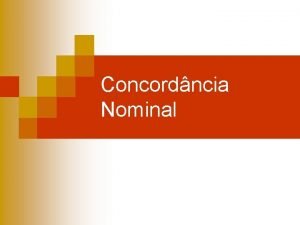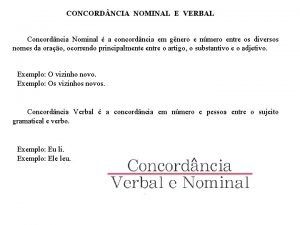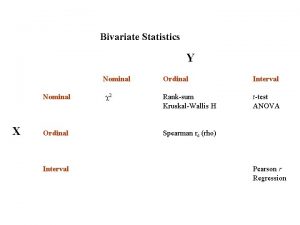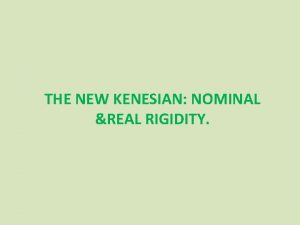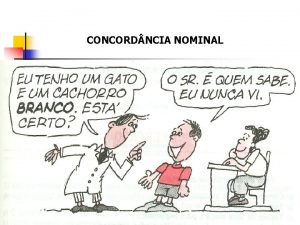MONEY AND INVESTING Money Management Nominal and Effective






































- Slides: 38

. MONEY AND INVESTING Money Management Nominal and Effective Interest Rates Equivalence Calculations Changing Interest Rates Debt Management (c) 2001 Contemporary Engineering Economics 1

Focus 1. If payments occur more frequently than annual, how do we calculate economic equivalence? 2. If interest period is other than annual, how do we calculate economic equivalence? 3. How are commercial loans structured? 4. How should you manage your debt? (c) 2001 Contemporary Engineering Economics 2

Nominal Versus Effective Interest Rates Nominal Interest Rate: Interest rate quoted based on an annual period Effective Interest Rate: Actual interest earned or paid in a year or some other time period (c) 2001 Contemporary Engineering Economics 3

18% Compounded Monthly Nominal interest rate Interest period Annual percentage rate (APR) (c) 2001 Contemporary Engineering Economics 4

Effective Annual Interest Rate r = nominal interest rate per year ia = effective annual interest rate M = number of interest periods per year (c) 2001 Contemporary Engineering Economics 5

18% compounded monthly • Question: Suppose that you invest $1 for 1 year at 18% compounded monthly. How much interest would you earn? • Solution: = $1. 1956 0. 1956 or 19. 56% 18% : 1. 5% (c) 2001 Contemporary Engineering Economics 6

18% : 1. 5% 18% compounded monthly or 1. 5% per month for 12 months = 19. 56 % compounded annually (c) 2001 Contemporary Engineering Economics 7

Nominal and Effective Interest Rates with Different Compounding Periods Effective Rates Nominal Rate Compounding Annually Compounding Semi-annually Compounding Quarterly Compounding Monthly Compounding Daily 4% 4. 00% 4. 04% 4. 06% 4. 07% 4. 08% 5 5. 00 5. 06 5. 09 5. 12 5. 13 6 6. 00 6. 09 6. 14 6. 17 6. 18 7 7. 00 7. 12 7. 19 7. 23 7. 25 8 8. 00 8. 16 8. 24 8. 30 8. 33 9 9. 00 9. 20 9. 31 9. 38 9. 42 10 10. 00 10. 25 10. 38 10. 47 10. 52 11 11. 00 11. 30 11. 46 11. 57 11. 62 12 12. 00 12. 36 12. 55 12. 68 12. 74 (c) 2001 Contemporary Engineering Economics 8

Effective Annual Interest Rates (9% compounded quarterly) First quarter Base amount + Interest (2. 25%) $10, 000 + $225 Second quarter = New base amount + Interest (2. 25%) = $10, 225 +$230. 06 Third quarter = New base amount + Interest (2. 25%) = $10, 455. 06 +$235. 24 Fourth quarter = New base amount + Interest (2. 25 %) = Value after one year = $10, 690. 30 + $240. 53 = $10, 930. 83 (c) 2001 Contemporary Engineering Economics 9

Effective Interest Rate per Payment Period (i) C = number of interest periods per payment period K = number of payment periods per year r/K = nominal interest rate per payment period (c) 2001 Contemporary Engineering Economics 10

12% compounded monthly Payment Period = Quarter Compounding Period = Month 1 st Qtr 1% 1% 1% 3. 030 % 2 nd Qtr 3 rd Qtr 4 th Qtr One-year • Effective interest rate per quarter • Effective annual interest rate (c) 2001 Contemporary Engineering Economics 11

Effective Interest Rate per Payment Period with Continuous Compounding where CK = number of compounding periods per year continuous compounding => (c) 2001 Contemporary Engineering Economics 12

Case 0: 8% compounded quarterly Payment Period = Quarter Interest Period = Quarterly 1 st Q 2 nd Q 1 interest period 3 rd Q 4 th Q Given r = 8%, K = 4 payments per year C = 1 interest periods per quarter M = 4 interest periods per year (c) 2001 Contemporary Engineering Economics 13

Case 1: 8% compounded monthly Payment Period = Quarter Interest Period = Monthly 1 st Q 2 nd Q 3 interest periods 3 rd Q 4 th Q Given r = 8%, K = 4 payments per year C = 3 interest periods per quarter M = 12 interest periods per year (c) 2001 Contemporary Engineering Economics 14

Case 2: 8% compounded weekly Payment Period = Quarter Interest Period = Weekly 1 st Q 2 nd Q 13 interest periods 3 rd Q 4 th Q Given r = 8%, K = 4 payments per year C = 13 interest periods per quarter M = 52 interest periods per year (c) 2001 Contemporary Engineering Economics 15

Case 3: 8% compounded continuously Payment Period = Quarter Interest Period = Continuously 1 st Q 2 nd Q interest periods 3 rd Q 4 th Q Given r = 8%, K = 4 payments per year (c) 2001 Contemporary Engineering Economics 16

Summary: Effective interest rate per quarter Case 0 Case 1 Case 2 Case 3 8% compounded quarterly monthly weekly continuously Payments occur quarterly 2. 000% per quarter 2. 013% per quarter 2. 0186% per quarter 2. 0201% per quarter (c) 2001 Contemporary Engineering Economics 17

Equivalence Analysis using Effective Interest Rate • Step 1: Identify the payment period (e. g. , annual, quarter, month, week, etc) • Step 2: Identify the interest period (e. g. , annually, quarterly, monthly, etc) • Step 3: Find the effective interest rate that covers the payment period. (c) 2001 Contemporary Engineering Economics 18

Principle: Find the effective interest rate that covers the payment period Case 1: compounding period = payment period (Example 5. 5) Case 2: compounding period < payment period (Examples 5. 7 and 5. 8) Case 3: compounding period > payment period (Example 5. 9) (c) 2001 Contemporary Engineering Economics 19

Case I: When Payment Periods and Compounding periods coincide Step 1: Identify the number of compounding � periods (M) per year Step 2: Compute the effective interest rate per � payment period (i) i = r/M Step 3: Determine the total number of payment � periods (N) N = M (number of years) Step 4: Use the appropriate interest formula � using i and N above (c) 2001 Contemporary Engineering Economics 20

Example 5. 5: Calculating Auto Loan Payments Given: Invoice Price = $21, 599 � Sales tax at 4% = $21, 599 (0. 04) = $863. 96 � Dealer’s freight = $21, 599 (0. 01) = $215. 99 � Total purchase price = $22, 678. 95 � Down payment = $2, 678. 95 � Dealer’s interest rate = 8. 5% APR � Length of financing = 48 months � Find: the monthly payment � (c) 2001 Contemporary Engineering Economics 21

Example 5. 5: Payment Period = Interest Period $20, 000 1 2 3 4 48 0 A Given: P = $20, 000, r = 8. 5% per year K = 12 payments per year N = 48 payment periods Find A �tep 1: M = 12 S Step 2: i = r/M = 8. 5%/12 = 0. 7083% per month � Step 3: N = (12)(4) = 48 months � Step 4: A = $20, 000(A/P, 0. 7083%, 48) = $492. 97 � (c) 2001 Contemporary Engineering Economics 22

Dollars Up in Smoke What three levels of smokers who bought cigarettes every day for 50 years at $1. 75 a pack would have if they had instead banked that money each week: Level of smoker Would have had 1 pack a day $169, 325 2 packs a day $339, 650 3 packs a day $507, 976 Note: Assumes constant price per pack, the money banked weekly and an annual interest rate of 5. 5% Source: USA Today, Feb. 20, 1997 (c) 2001 Contemporary Engineering Economics 23

Sample Calculation: One Pack per Day Step 1: Determine the effective interest rate per payment period. Payment period = weekly “ 5. 5% interest compounded weekly” i = 5. 5%/52 = 0. 10577% per week Step 2: Compute the equivalence value. Weekly deposit amount A = $1. 75 x 7 = $12. 25 per week Total number of deposit periods N = (52 weeks/yr. )(50 years) = 2600 weeks F = $12. 25 (F/A, 0. 10577%, 2600)= $169, 325 (c) 2001 Contemporary Engineering Economics 24

Case II: When Payment Periods Differ from Compounding Periods Step 1: Identify the following parameters � M = No. of compounding periods K = No. of payment C = No. of interest periods per payment period Step 2: Compute the effective interest rate per payment � period • For discrete compounding • For continuous compounding Step 3: Find the total no. of payment periods � N = K (no. of years) Step 4: Use i and N in the appropriate equivalence formula � (c) 2001 Contemporary Engineering Economics 25

Discrete Case: Quarterly deposits with Monthly compounding Year 1 0 1 2 3 Year 2 4 5 6 7 F=? Year 3 8 9 10 11 12 Quarters A = $1, 000 � Step 1: M = 12 compounding periods/year K = 4 payment periods/year C = 3 interest periods per quarter � Step 2: � Step 3: N = 4(3) = 12 � Step 4: F = $1, 000 (F/A, 3. 030%, 12) = $14, 216. 24 (c) 2001 Contemporary Engineering Economics 26

Continuous Case: Quarterly deposits with Continuous compounding Year 1 0 1 2 3 Year 2 4 5 6 7 F=? Year 3 8 9 10 11 12 Quarters A = $1, 000 � Step 1: K = 4 payment periods/year C = interest periods per quarter � Step 2: � Step 3: N = 4(3) = 12 � Step 4: F = $1, 000 (F/A, 3. 045%, 12) = $14, 228. 37 (c) 2001 Contemporary Engineering Economics 27

Credit Card Debt • Annual fees • Annual percentage rate • Grace period • Minimum payment • Finance charge (c) 2001 Contemporary Engineering Economics 28

Methods of Calculating Interests on your Credit Card Method Description Interest You Owe Adjusted Balance The bank subtracts the amount of your payment from the beginning balance and charges you interest on the remainder. This method costs you the least. Your beginning balance is $3, 000. With the $1, 000 payment, your new balance will be $2, 000. You pay 1. 5% on this new balance, which will be $30. Average Daily Balance The bank charges you interest on the average of the amount you owe each day during the period. So the larger the payment you make, the lower the interest you pay. Your beginning balance is $3, 000. With your $1, 000 payment at the 15 th day, your balance will be reduced to $2, 000. Therefore, your average balance will be (1. 5%)($3, 000+$2, 000)/2=$37. 50. Previous Balance The bank does not subtract any payments you make from your previous balance. You pay interest on the total amount you owe at the beginning of the period. This method costs you the most. Regardless of your payment size, the bank will charge 1. 5% on your beginning balance $3, 000: (1. 5%)($3, 000)=$45. (c) 2001 Contemporary Engineering Economics 29

Commercial Loans Amortized Loans � • Effective interest rate specified • Paid off in installments over time • Examples: Auto-loans, home mortgage loans, most business loans Add-on Loans � • Simple interest rate specified to pre-calculate the total interest • • Examples: financing furniture and appliances (c) 2001 Contemporary Engineering Economics 30

Amortized Loan - Auto Loan $20, 000 1 2 24 25 48 0 Given: APR = 8. 5%, N = 48 months, and P = $20, 000 Find: A A = $20, 000(A/P, 8. 5%/12, 48) = $492. 97 (c) 2001 Contemporary Engineering Economics 31

Suppose you want to pay off the remaining loan in lump sum right after making the 25 th payment. How much would this lump be? $20, 000 1 2 48 24 25 0 $492. 97 25 payments that were already made $492. 97 23 payments that are still outstanding P = $492. 97 (P/A, 0. 7083%, 23) = $10, 428. 96 (c) 2001 Contemporary Engineering Economics 32

Add-on Loans Given: You borrow $5, 000 for 2 years at an add-on rate of 12% with equal payments due at the end of each month. Add-on Interest: � (0. 12)($5, 000)(2) = $1, 200 Principal + add-on interest � $5, 000 + $1, 200 = $6, 200 Monthly Installments � A = $6, 200/24 = $258. 33 Find: the effective interest rate for this add-on loan (c) 2001 Contemporary Engineering Economics 33

$5, 000 1 2 i=? 24 0 A = $258. 33 $5, 000 = $258. 33 (P/A, i, 24) = 19. 3551 By trial and error method, we find • i = 1. 7975% per month • r = 1. 7975% x 12 = 21. 57% per year • (c) 2001 Contemporary Engineering Economics 34

Buying vs. Lease • Cost to Buy : $25, 886 Down payment: $2, 100 Car Loan at 8. 5% (48 payments of $466): $22, 368 Sales tax (at 6. 75%): $1, 418 • Cost to Lease : $15, 771 Lease (48 payments of $299) : $14, 352 Sales tax (at 6. 75%): $969 Document fee: $450 Refundable security deposit (not included (c) 2001 Contemporary Engineering 35 in total) : $300 Economics

Buying versus Lease Decision Option 1 Debt Financing Option 2 Lease Financing Price $14, 695 Down payment $2, 000 0 APR (%) 3. 6% Monthly payment Length $372. 55 $236. 45 36 months Fees $495 Cash due at lease end $300 Purchase option at lease end Cash due at signing $8. 673. 10 $2, 000 (c) 2001 Contemporary Engineering Economics $731. 45 36

(c) 2001 Contemporary Engineering Economics 37

Which Option is Better? • Debt Financing: Pdebt = $2, 000 + $372. 55(P/A, 0. 5%, 36) - $8, 673. 10(P/F, 0. 5%, 36) = $6, 998. 47 • Lease Financing: Please = $495 + $236. 45(P/A, 0. 5%, 35) + $300(P/F, 0. 5%, 36) = $8, 556. 90 (c) 2001 Contemporary Engineering Economics 38
 Direct investing vs indirect investing
Direct investing vs indirect investing Money money money team
Money money money team Nominal.interest rate
Nominal.interest rate Foreign exchange means
Foreign exchange means Effective interest rate formula
Effective interest rate formula Real vs nominal money
Real vs nominal money Lesson twelve saving and investing
Lesson twelve saving and investing Financing and investing cycle
Financing and investing cycle Chapter 10 basics of saving and investing
Chapter 10 basics of saving and investing Chapter 10 basics of saving and investing
Chapter 10 basics of saving and investing Cash flow indirect method
Cash flow indirect method Operating activities indirect method
Operating activities indirect method Lesson 16-2 saving and investing answer key
Lesson 16-2 saving and investing answer key Chapter 6 saving and investing
Chapter 6 saving and investing Sephora direct
Sephora direct Explain the investment poem concerning stocks and bonds.
Explain the investment poem concerning stocks and bonds. Saving vs investing venn diagram answers
Saving vs investing venn diagram answers Symbols that represent jay gatsby
Symbols that represent jay gatsby Money smart money match
Money smart money match Money on money multiple
Money on money multiple The great gatsby historical background
The great gatsby historical background Context of the great gatsby
Context of the great gatsby Operating activities vs investing activities
Operating activities vs investing activities Fundamentals of investment notes
Fundamentals of investment notes The basic rule of a risk-to-return relationship is that …
The basic rule of a risk-to-return relationship is that … Option premium
Option premium Value investing damodaran
Value investing damodaran Great good gruesome
Great good gruesome Future smart growing a business answers
Future smart growing a business answers Investing in megachallenges
Investing in megachallenges Bad debt expense cash flow statement direct method
Bad debt expense cash flow statement direct method Define contrarian investing
Define contrarian investing Derivative in investing
Derivative in investing Put and take account
Put and take account Cash flow statement format grade 12
Cash flow statement format grade 12 Investing activities meaning
Investing activities meaning Net cash flow from investing activities
Net cash flow from investing activities Value investing meetup
Value investing meetup Investing cycle in auditing
Investing cycle in auditing
